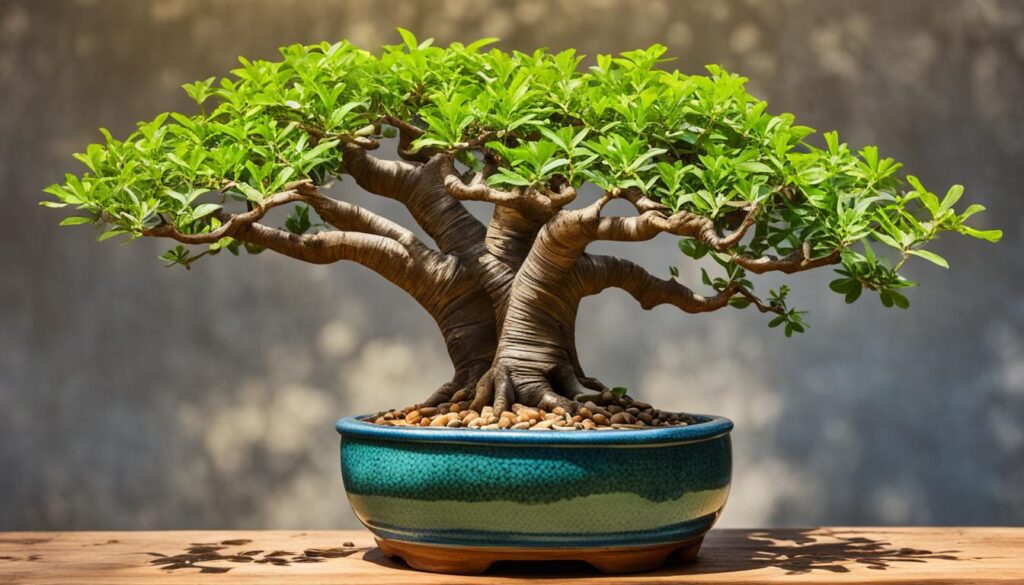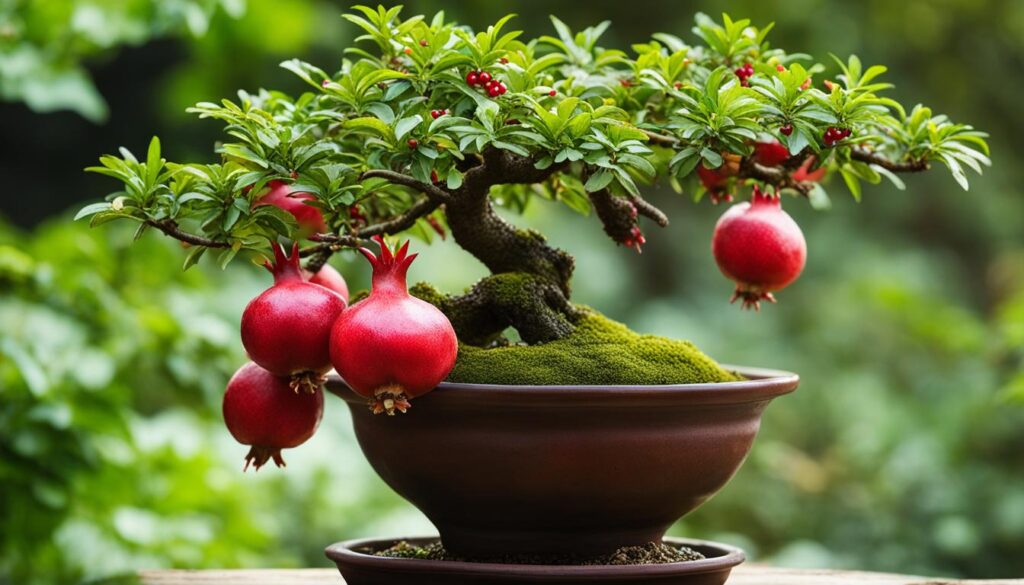Black Pine Bonsai, or Pinus thunbergii, is valued for its unique traits and adaptability. It is also among the fastest growing bonsai. This guide covers pruning, sunlight, watering, fertilizing, and tree selection.
With our help, you’ll learn how to care for black pine bonsai and create a beautiful addition to your indoor or outdoor space. Let’s explore how to nurture these trees.
Understanding the Unique Features of Black Pine Bonsai
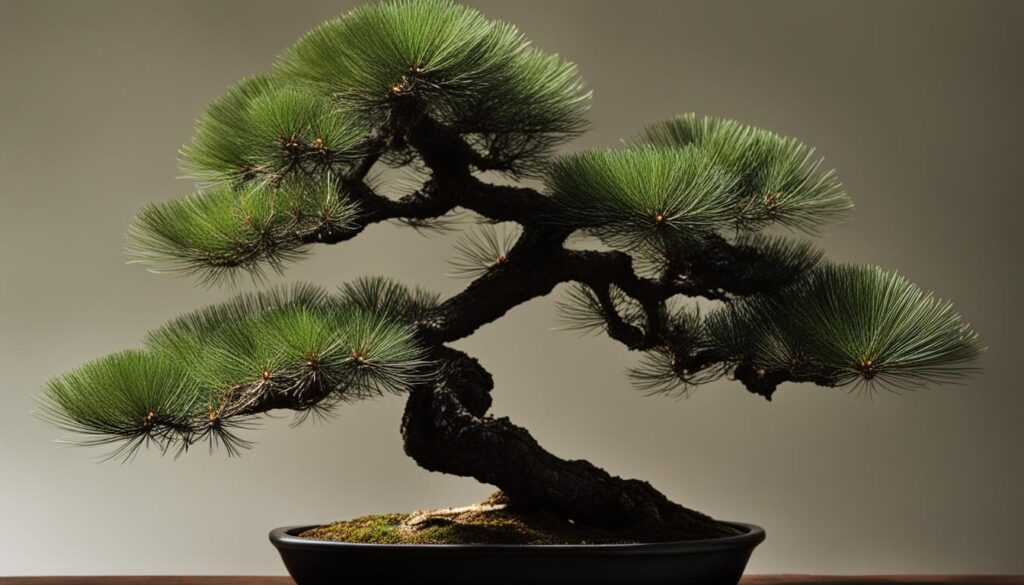
Black Pine Bonsai (Pinus thunbergii) stands out due to its unique traits. Knowing its growth patterns and habitat will help you care for this interesting plant better.
One Flush and Two Flush Growth in Pinus
Black Pine Bonsai shows unique growth behavior. Some Pinus types have one flush of growth each year, while others have two flushes. Recognizing this behavior is important for effective care.
The one flush growth pattern involves a strong growth surge in spring, lasting throughout the year. This pattern is common in young trees or those recently pruned or repotted. The two flush growth pattern has gradual growth, with a second burst in summer, seen mainly in mature Black Pine Bonsai, adding visual appeal.
Adaptation and Significance of the Black Pine’s Natural Habitat
Black Pine Bonsai comes from Japan’s coastal areas and adapts well to different climates and soils. This resilient tree thrives in sandy and rocky spots, tolerating strong winds and salt exposure.
Understanding the Black Pine’s habitat is key for bonsai cultivation. Replicating these conditions will help your Black Pine Bonsai’s health and unique traits.
Identifying Vendor-Grafted Japanese White Pines on Black Pine Rootstocks
In the bonsai market, it is important to recognize vendor-grafted Japanese White Pines on Black Pine rootstocks. Japanese White Pine (Pinus parviflora) often serves as a rootstock for Black Pine Bonsai, combining the attractive foliage of Black Pine with the advantages of Japanese White Pine roots.
To identify vendor-grafted Japanese White Pines, look for longer needles and variations in foliage color. These traits help you distinguish between Black Pine Bonsai and vendor-grafted Japanese White Pines on Black Pine roots, ensuring you select the right tree for your collection.
| Unique Features of Black Pine Bonsai | |
|---|---|
| Growth Patterns | One flush growth and two flush growth in Pinus |
| Adaptation | Thrives in sandy and rocky coastal areas |
| Significance | Mimicking coastal environment for optimal growth |
| Identification | Vendor-grafted Japanese White Pines on Black Pine rootstocks |
Optimal Bonsai Plant Care for Black Pine Bonsai

To keep your Black Pine Bonsai healthy and beautiful, follow these key aspects of bonsai plant care specific to Black Pine Bonsai:
- Proper watering practices: Black Pine Bonsai prefers consistent moisture. Water when the top layer of soil dries out, avoiding both overwatering and underwatering. Water thoroughly to ensure the entire root ball receives moisture.
- Sunlight requirements: Black Pine Bonsai thrives in full sun to partial shade. Place your bonsai where it gets at least 6 hours of direct sunlight each day. If growing indoors, use supplemental lights if needed.
- Fertilization techniques: Regular fertilization is crucial for healthy growth. Use a balanced, slow-release fertilizer or a bonsai-specific fertilizer during the growing season. Follow the dosage instructions and adjust based on your tree’s needs.
- General maintenance tips: Regular maintenance is necessary to ensure shape and health. This includes pruning to maintain form, removing dead branches, and repotting periodically to refresh soil and promote root growth.
To visualize the optimal care for Black Pine Bonsai, refer to the table below:
| Aspect of Care | Recommendation |
|---|---|
| Watering | Water thoroughly when the top layer of soil begins to dry out. Avoid overwatering and underwatering. |
| Sunlight | Place in a spot with at least 6 hours of direct sunlight per day. Supplemental lighting may be necessary for indoor cultivation. |
| Fertilization | Use a balanced, slow-release fertilizer or bonsai-specific fertilizer during the growing season. Adjust frequency and strength according to your tree’s needs. |
| Maintenance | Regularly prune to maintain shape, remove dead branches, and repot periodically to refresh soil and promote root growth. |
Placement and Sunlight Requirements for Bonsai Care
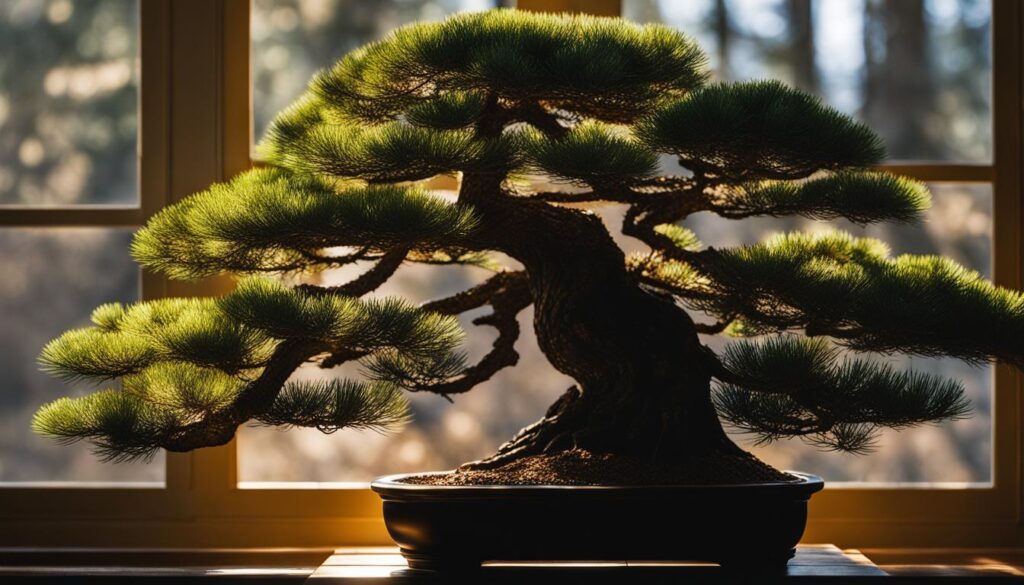
Placement and sunlight are essential for Black Pine Bonsai care. The location affects growth and health. Whether indoors or outdoors, provide ideal conditions for development and rapid growth.
For indoor placement, choose a location with ample natural light. A south-facing window is ideal, providing at least 6 hours of sunlight daily. Use artificial grow lights if natural light is limited.
For outdoor placement, consider your area’s climate and weather. Black Pine Bonsai thrives in full sun or partial shade. Protect your bonsai from extreme temperatures, strong winds, and frost in winter.
Rotate your bonsai regularly for even sunlight exposure to prevent leaning. By monitoring placement and sunlight, you can create an optimal environment for growth and enjoy a healthy bonsai tree.
Watering Practices for a Thriving Bonsai Plant
Proper watering is vital for your Black Pine Bonsai’s health. Follow these guidelines to ensure your tree gets the right amount of water:
- Check the soil moisture: Stick your finger about an inch deep into the soil. If it feels dry, it’s time to water. If it feels moist, wait.
- Watering frequency: Water thoroughly but less frequently. Water every 4-5 days during the growing season, adjusting based on your climate and tree’s needs.
- Watering technique: Gently water the soil surface, allowing the water to penetrate the entire root system. Avoid using strong jets, as they can disturb the soil and harm the roots.
- Drainage: Ensure your pot has proper drainage holes to prevent waterlogging. Excess water should drain freely.
Expert tip: Never let your Black Pine Bonsai completely dry out, as it can cause stress. Overwatering can lead to root rot. Find the right balance by monitoring soil moisture and adjusting your watering schedule.
Remember, watering needs vary based on climate, pot size, and tree age. Regularly check your tree’s moisture levels to provide the best watering for healthy growth.
Fertilizing Your Black Pine Bonsai: Best Practices and Timing
Fertilization is important for supplying your Black Pine Bonsai with nutrients for healthy growth. By using proper fertilizing methods, you can help your bonsai thrive and show vibrant foliage. This section covers best practices and timing for fertilizing your Black Pine Bonsai, including types of fertilizers, application techniques, and seasonal timing.
Types of Fertilizers:
When fertilizing your Black Pine Bonsai, choose the right type. Organic fertilizers, like fish emulsion, seaweed extract, and compost, provide slow-release nutrients and improve soil health. Inorganic fertilizers offer quick nutrients but must be used carefully to avoid burning the roots.
Application Techniques:
Apply fertilizer correctly to maximize its effectiveness. Use a balanced fertilizer with a 10-10-10 NPK ratio. Spread it evenly across the soil surface, avoiding contact with the trunk and foliage. Always follow the manufacturer’s instructions for application rates and frequency.
Seasonal Timing:
Timing is critical for healthy growth. Apply balanced fertilizer every two to four weeks during the growing season in spring and summer. As winter approaches, reduce or stop fertilizing to allow your bonsai to rest before the next growing season.
Fertilizing your Black Pine Bonsai is key to bonsai care. By following proper practices and timing, you can ensure your bonsai receives the nutrients it needs for optimal growth. Adjust your fertilization routine based on your Black Pine Bonsai’s specific needs.
Pruning Bonsai Trees: Techniques for Black Pines
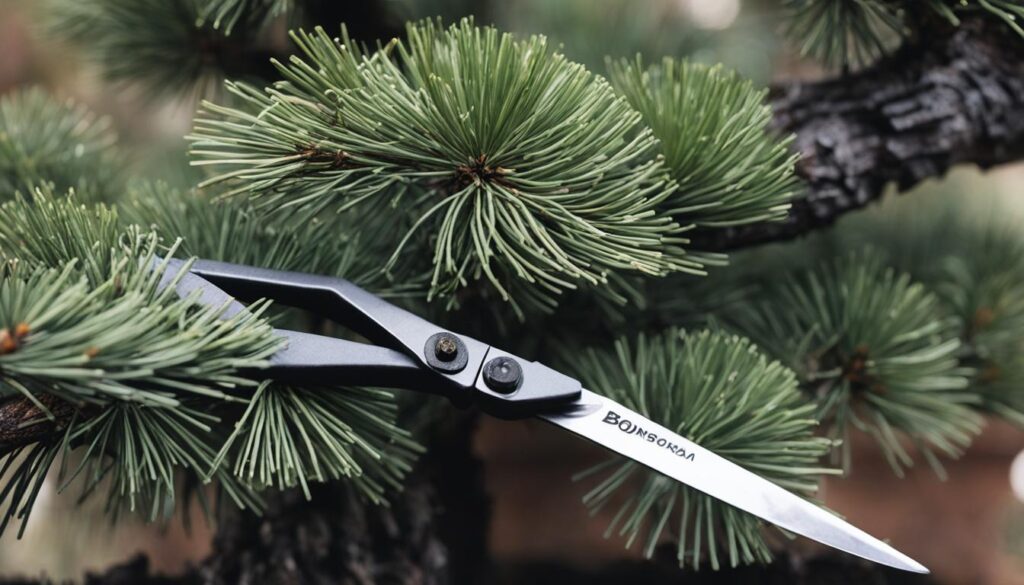
Pruning is crucial for shaping and maintaining the aesthetics of your Black Pine Bonsai. By using proper pruning techniques, you can keep your bonsai visually appealing and healthy. This section explores specific pruning techniques for Black Pines, including branch pruning, candle pruning, and needle plucking.
Branch pruning involves selectively removing branches to create balance and shape. Prune in late winter or early spring before new growth starts. This helps the tree recover quickly and promotes vigorous growth.
Candle pruning encourages compact growth in Black Pines. Remove elongated shoots during spring before they fully extend. This redirects the tree’s energy towards lateral growth for denser foliage.
Needle plucking removes old or damaged needles. This improves the tree’s appearance and health. By plucking selectively, you enhance air circulation and sunlight penetration, reducing disease risk and encouraging new bud development.
Always use sharp, clean pruning tools to limit damage and prevent disease spread. Prune carefully to maintain your tree’s natural form and avoid excessive pruning, which can weaken it.
Mastering bonsai pruning takes practice. With time, you’ll develop an eye for shaping your Black Pine Bonsai and maintaining its health. Enjoy the rewarding process of crafting a beautiful bonsai tree.
Black Pine Bonsai for Sale: Selecting and Purchasing the Right Tree
If you want to add a Black Pine Bonsai to your collection, know how to select and purchase the right tree. Consider tree age, health, and aesthetics to make an informed decision.
Start by looking for a tree with a desirable age. Younger trees allow more flexibility in shaping and styling. Older trees may have a well-established form and mature faster.
Tree health is crucial. Look for Black Pine Bonsai with vibrant foliage, healthy bark, and no signs of pests or diseases. Inspect the root system to ensure it is well-developed and not pot-bound.
Aesthetics matter in the selection process. Take time to find a Black Pine Bonsai with a pleasing trunk shape and balanced branching. Remember, bonsai trees are living artworks, so find one that resonates with your taste.
Unlock the Secrets of Bonsai Trees: The Ultimate Guide Revealed! >>>
Growing a Stunning Redwood Bonsai Tree: Your Ultimate Care Guide! >>>
Thriving Cherry Blossom Bonsai: The Ultimate Growing and Care Guide! >>>


